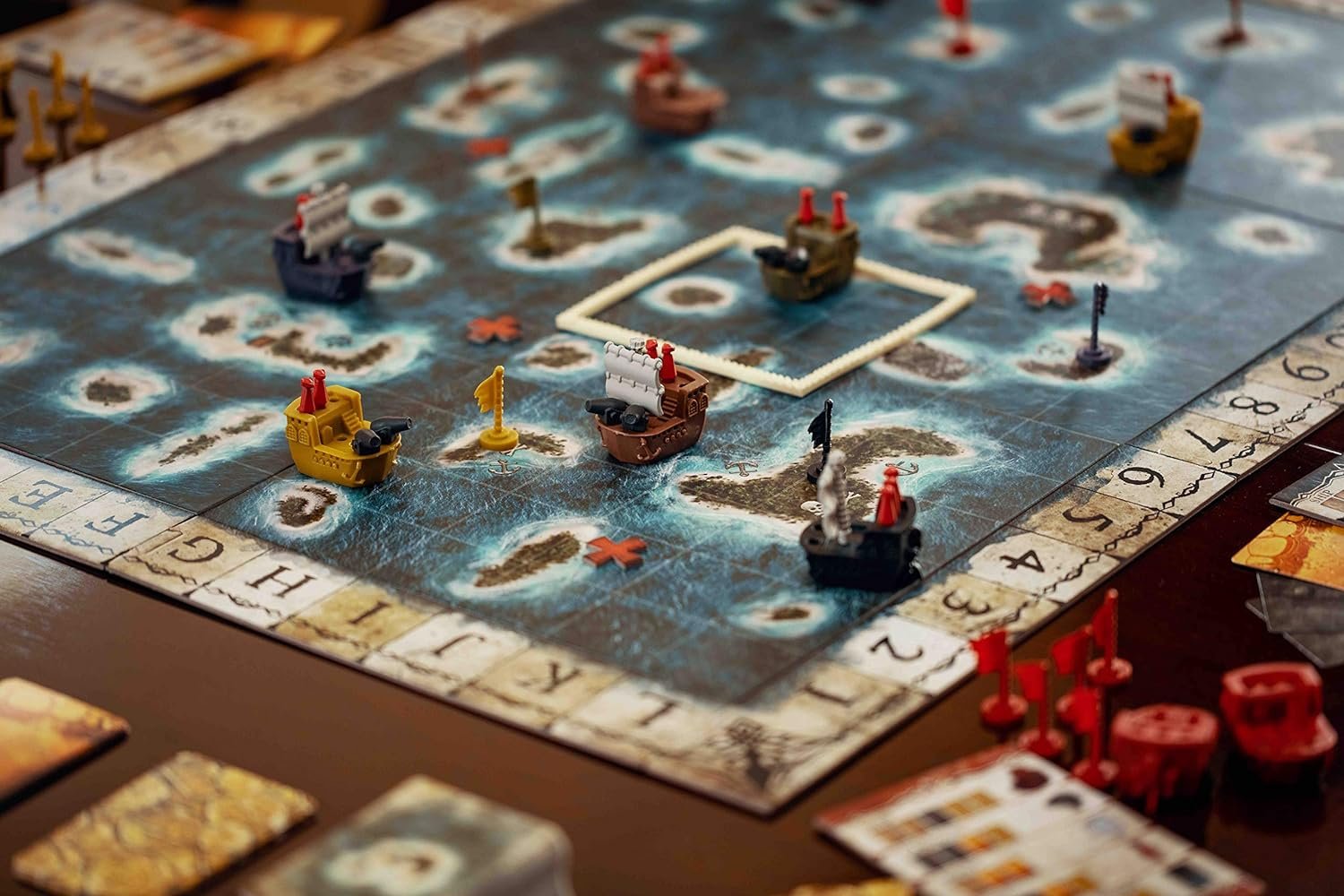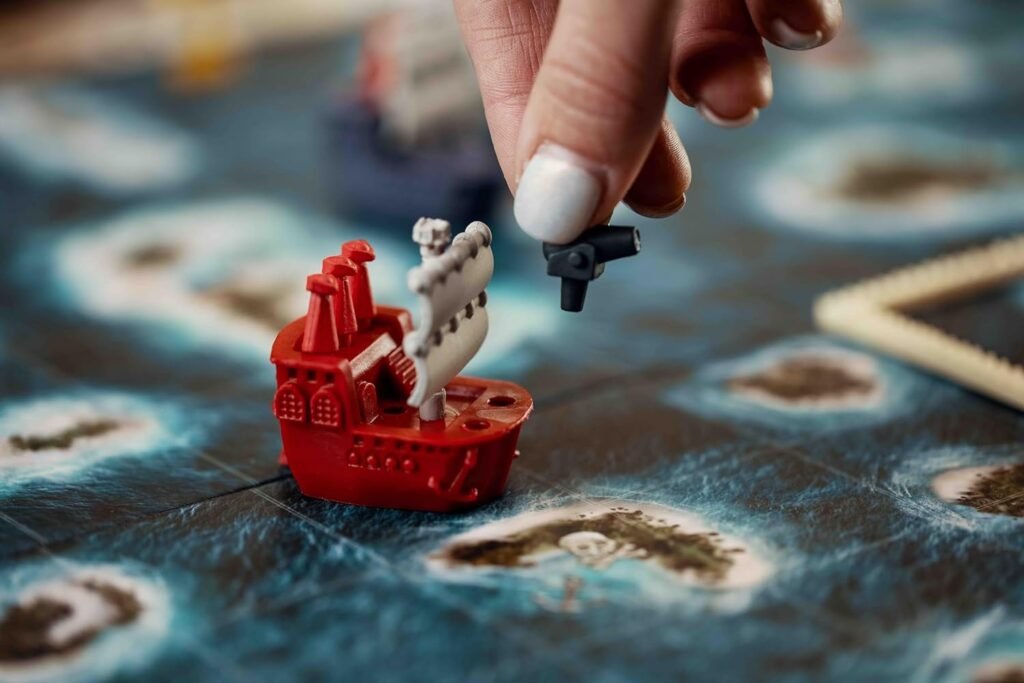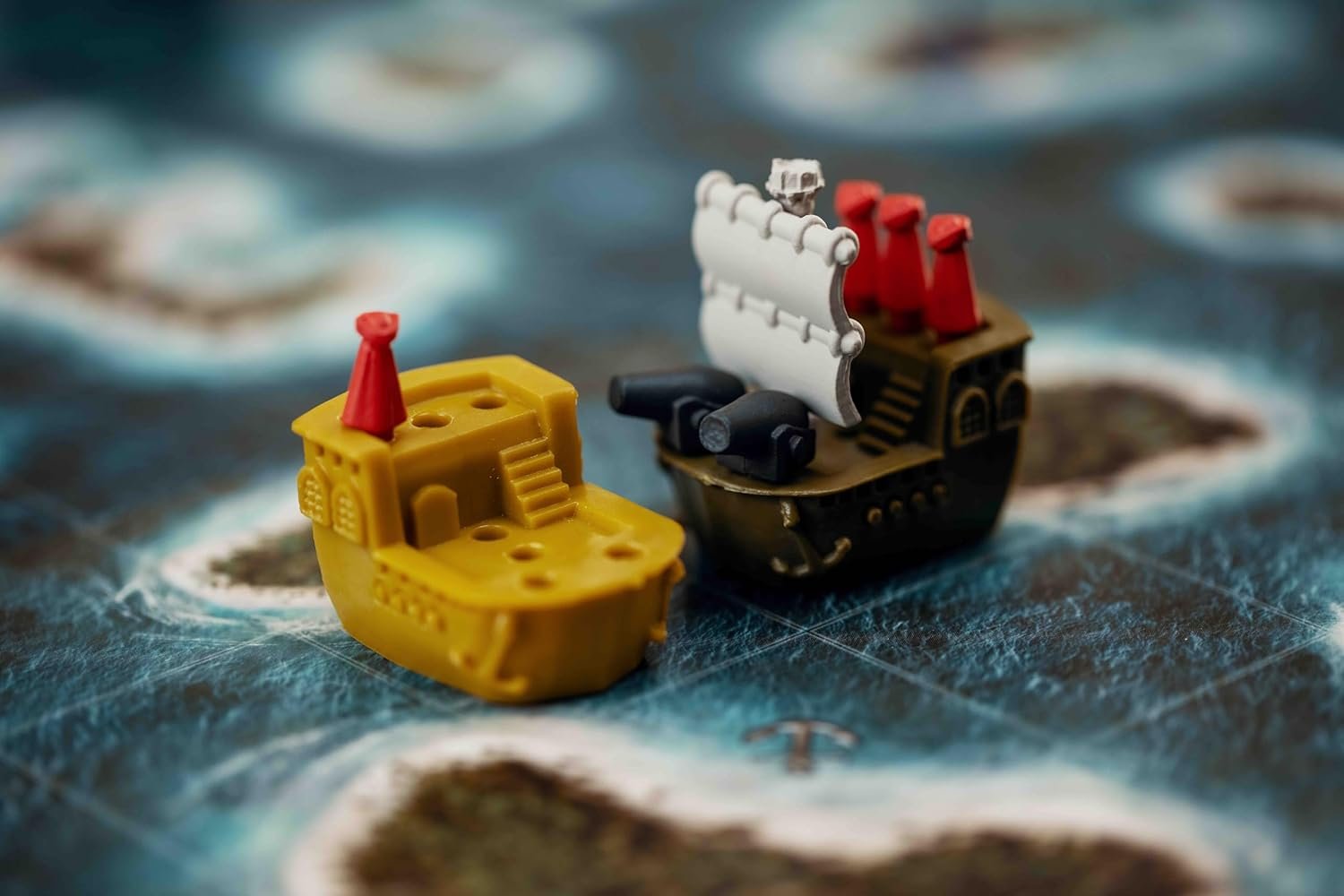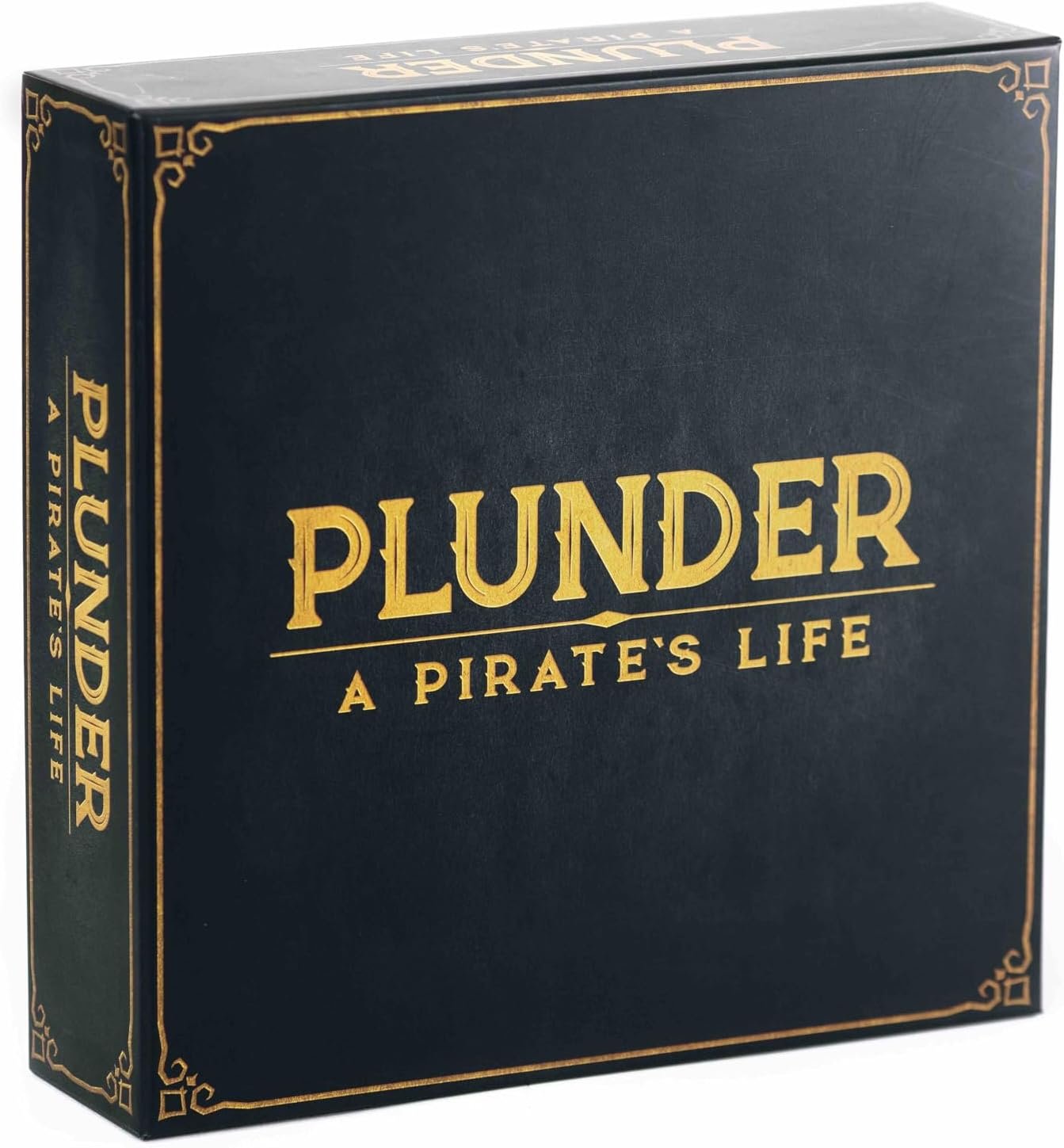
Today we’re diving into Plunder: A Pirate’s Life. This is a board game from Lost Boy Entertainment that lets you embrace your inner buccaneer, sailing the high seas, battling for islands, & hunting treasure. So, let’s break it down—what it is, what’s good, what’s bad, & if you should pick it up. Let’s get into it.

What It Is
Plunder: A Pirate’s Life is a pirate-themed board game for 2-6 players, where you take on the role of a pirate captain trying to be the first to reach 10 plunder points. Starting with a single island & ship, players build fleets, conquer territories, & fight rival pirates. The core gameplay is straightforward—draw resources, roll to move, & decide on actions like attacking, trading, or seeking treasure. The game is loaded with pirate flair, from the modular map with various island types to the storm that roams the board, affecting ships & gameplay alike.
Check Out These Recent Board Game Sales
- Board Game Sale: Disney Villainous 25% Off!
- Board Game Sale: Marvel: Crisis Protocol Core Set 30% Off!
- Board Game Sale: 7 Wonders Available for 17% Off!
Gameplay Overview
Plunder: A Pirate’s Life invites players into a thrilling world of high-seas adventure where they take on the roles of pirates sailing the open waters in search of treasure, fame, & power. The game combines resource management, strategy, & player interaction, creating an engaging pirate-themed experience. Each game session is unique, with the board featuring a modular setup made of an outer frame & six randomly arranged island tiles, ensuring that no two games are the same.
Setting up the game involves strategically placing buried treasure across the map. Using compass wheels to determine coordinates, players place treasure pieces around the islands based on the player count, giving each session a dynamic & unpredictable layout. Additionally, a 3×3 storm tile adds an extra challenge, positioned randomly on the board with compass wheels, adding new obstacles for players to navigate as they chart their course.
Resource management plays a central role in Plunder: A Pirate’s Life. Players gather wood, iron, gold, & rum from resource card stacks, each representing vital supplies for upgrading ships, building new vessels, & preparing for combat. At the start of each turn, players gain resources according to the number of skull islands they control. These resources fuel players’ pirate enterprises, enabling them to strengthen their fleets & pursue victory through exploration, combat, & trading.
Each player starts with three ships, six flags, & a player aid card, along with three life tokens per ship. Beginning on a single-skull island, players move their ships across the board, rolling a sailing die to determine movement distance. Ships can travel horizontally or vertically across the map, but entry to certain areas, like ports, requires specific approaches. This movement adds an element of strategic planning, as players must navigate carefully to reach their goals without getting caught in dangerous waters.
Combat is a central part of Plunder: A Pirate’s Life, as players can engage both islands & other ships in battles for control & resources. Attacks involve rolling dice, with bonuses for ships equipped with cannons or islands marked with skulls. Victorious players claim control of islands or damage enemy ships, earning plunder points for successful skirmishes. In ship-to-ship combat, the losing ship takes damage, & if a ship sinks, the attacking player gains a plunder point, adding to their quest for victory.
Trading & resource management add additional layers of strategy. Players can trade resources with each other under specific conditions, such as when they’re near a merchant island or adjacent to another player’s ship. These interactions open opportunities for negotiation, temporary alliances, & even bribes to deter attacks. The game’s design encourages players to form & break alliances as it suits them, with deals often lasting only a turn as players continuously vie for control of the seas.
Treasure hunting is another path to victory. When a ship reaches an ‘X’ on the map, the player can search for treasure, drawing cards from a treasure deck that holds surprises & potential risks. Some treasures offer powerful advantages, while others may end a turn early, introducing an element of luck that keeps players on their toes. Meanwhile, the storm tile drifts across the board whenever a player rolls a 1, shifting its effects on resource production, ship movement, & adjacency rules, further complicating strategies.
Victory in Plunder: A Pirate’s Life is achieved by being the first to reach 10 plunder points. Points are gained through sinking enemy ships, controlling islands, finding treasure, or purchasing plunder point cards with gold resources. With its mix of resource management, strategic combat, & unpredictable elements, Plunder: A Pirate’s Life offers an exciting, competitive experience that immerses players in the thrill & challenges of life as a pirate.

The Components
One thing that stands out in Plunder is the component quality. The plastic ships are chunky & well-made, capturing that old-school pirate vibe perfectly. The modular board consists of six double-sided tiles, allowing for varied setups & extending the game’s replayability. Classic spinners determine treasure & storm locations, adding to the thematic feel of the game. With vibrant artwork, durable pieces, & a fun nautical theme, Plunder is visually engaging & feels great to play with.
The Good
Plunder: A Pirate’s Life is easy to learn & accessible for a broad audience, making it a great choice for families or casual game nights. The straightforward rules allow new players to dive right in, while the pirate theme & mechanics keep everyone engaged. The roaming storm & the ability to negotiate, trade, or even threaten other players adds layers of interaction that can lead to unexpected alliances or betrayals, which makes for memorable moments on the board.
The game also offers plenty of customization, letting you upgrade ships in different ways to match your preferred playstyle. Whether you want a fast ship with extra masts, a powerful attacker loaded with cannons, or a resilient vessel with extra lives, there’s room for varied strategies. The modular map, different island types, & random setup options add replay value, so you’ll rarely see the same game twice. For players who enjoy thematic games, Plunder delivers on the pirate adventure experience.

The Bad
However, Plunder leans heavily on luck-based mechanics, especially with its roll-and-move system, which might feel limiting to players who prefer more strategic depth. Dice rolls not only determine movement but also impact combat outcomes, which means there’s always an element of unpredictability that can swing gameplay in unexpected ways. For players who crave more control, this randomness could be a downside & might make the game feel too light or reliant on luck.
Another potential drawback is pacing, particularly at higher player counts. As players expand their fleets & control more territory, turns can drag out, leading to increased downtime for others at the table. This might make the game feel longer than it needs to be, especially if there’s a lot of back-and-forth combat or resource denial. While Plunder offers plenty of interaction, it may not be the best fit for players looking for a fast-paced experience, as it tends to slow down as the game progresses.
The Verdict
So, should you buy Plunder: A Pirate’s Life? If you’re a fan of pirate themes & enjoy a lighthearted, interactive board game, Plunder is a fantastic pick. The game’s emphasis on exploration, naval combat, & negotiation brings out that swashbuckling spirit & provides a lot of fun moments. Its component quality is top-notch, & the mechanics are easy enough for kids or non-gamers to pick up, making it perfect for family game nights.
For serious board gamers who prefer more strategic or less luck-dependent gameplay, Plunder may feel a bit shallow. The reliance on dice rolls for both movement & combat introduces a strong element of chance, which can overshadow careful planning. While expansions or added house rules could address this to an extent, Plunder might not satisfy players seeking a deeply strategic or complex pirate experience.

Final Thoughts
Plunder: A Pirate’s Life definitely hits the mark for a fun, easygoing experience. If you’re looking for a game that you can jump into without much prep & just have a blast sailing around, fighting other ships, & hunting treasure, then this game will be right up your alley. It’s the kind of game that doesn’t demand too much of you; you can get a feel for it in just a few rounds, & everyone will quickly start figuring out their pirate strategy, whether it’s focused on upgrading ships, conquering islands, or messing with opponents.
One of my favorite parts about Plunder is the freedom to try out different tactics as you play. You’re not locked into one way of winning, & the flexibility lets you experiment a bit each game. Plus, the interaction with other players is more engaging than just taking your turn & moving on. You can attack ships, form alliances, trade resources, or even just be a little chaotic with the roaming storm. All of that makes the game feel active & dynamic—you’re not just watching others take their turns; you’re involved in what everyone is doing, & that keeps it lively.
The game’s production quality also stood out to me. There’s something satisfying about moving those chunky plastic ships across the board, especially as you add upgrades like masts & cannons. The modular board is a nice touch, too, as it adds some replayability by letting you switch things up every game. & the spinners for treasure locations & the storm add that classic board game vibe, which really fits the pirate theme here. For a pirate game, it feels just right: thematic & easy to get into without needing tons of little pieces to manage.
Now, I will say that the dice-rolling aspect can make things a bit unpredictable, which isn’t always ideal if you’re hoping for a fully strategic experience. Movement & combat rely on the luck of the dice, & that can sometimes feel frustrating if you’re at the mercy of a low roll. It’s fun in the sense that anything can happen, but if you’re looking for tight strategy, you might feel like you’re not fully in control. It’s not a dealbreaker by any means, but definitely something to know going in.
Another thing to consider is that with more players, the game can stretch on, especially as everyone starts building up their fleets & going after more islands. If you’re playing with a full group, be prepared for a bit of downtime. Personally, I think the sweet spot is probably around three or four players—enough to keep things interactive without slowing down too much.
In the end, Plunder: A Pirate’s Life nails what it sets out to do: it’s a light, pirate-themed romp that’s perfect for family nights or a relaxed game session with friends. It’s not trying to be the deepest strategy game out there, & that’s part of its charm. If you’re in the mood for a game that lets you dive into a world of high-seas adventure with some friendly competition (and a little bit of chaos), this one’s definitely worth a try. Just gather your crew, set sail, & have fun with it—it’s as simple as that.
Purchase Options


At no extra cost to you, The Board Game Site may receive revenue from affiliate and advertising partnerships for sharing this content and from purchases through links.








